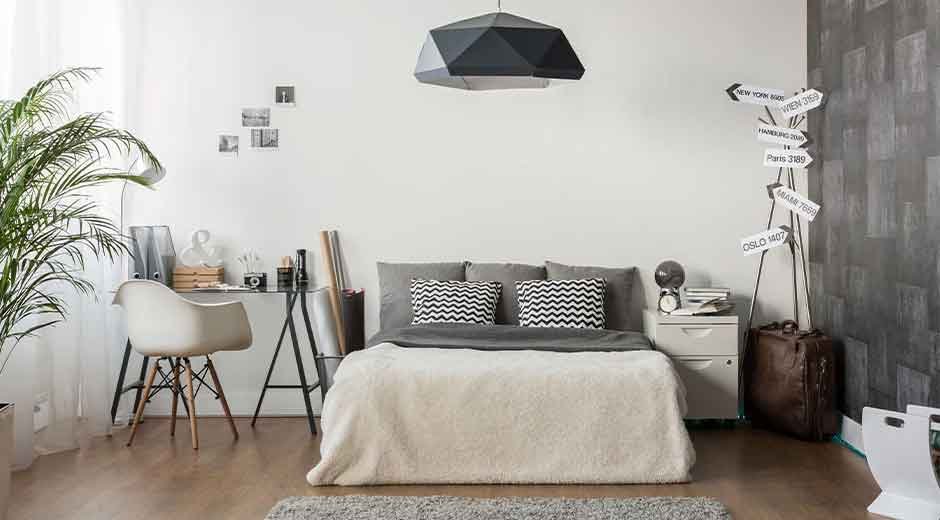Getting a good night’s sleep isn’t just about going to bed earlier or drinking chamomile tea before bed. Your bedroom environment plays a huge role in determining the quality of your rest. From the lighting to your choice of bedding, your bedroom can either support or sabotage your sleep.
Table of Contents
Optimize Lighting for Relaxation
Lighting has a profound impact on your sleep cycle. Bright LED lights or harsh overhead lighting during your evening hours can trick your brain into thinking it’s still daytime, making it harder for your body to wind down. Instead, focus on creating a dim and cozy atmosphere after sunset.
Switch to Soft, Warm Light Bulbs
Replace cool-toned LED bulbs with warm, dimmable lighting options. Amber or yellow-hued lights mimic the soft, natural glow of the setting sun and encourage melatonin production, a hormone essential for sleep.
Add Layers to Your Lighting
Avoid relying on one single overhead light. Layer your lighting instead, using bedside lamps, string lights, or wall sconces in strategic areas. These create a more inviting mood while giving you control over light intensity.
Block Outside Light with Blackout Curtains
If streetlights or morning sunlight seep into your bedroom, blackout curtains or window shades are a game-changer. They block external light and create a pitch-dark sleeping environment, ideal for uninterrupted rest.
Choose Calming Colors and Décor
Your bedroom color palette can significantly influence your mood. Bright or overly stimulating colors like red and neon yellow are best avoided. Instead, opt for soft, calming tones that create a serene ambiance.
Paint Your Walls in Relaxing Shades
Cool tones like blue, green, and lavender are known to promote tranquility and relaxation. For example, a Key West painting, inspired by breezy sunsets and fresh ocean breezes, is perfect for transforming your bedroom into a peaceful retreat. Pair these hues with neutral or pastel accents to maintain balance in the design.
Use Minimalistic Décor
Clutter and excessive decorative items can feel overwhelming. Stick to a “less is more” approach by choosing a few well-placed statement pieces, like a soft rug, cozy throw blankets, or framed artwork that complements your chosen color scheme.
Invest in a Quality Mattress and Bedding
An old or uncomfortable mattress can be a silent culprit behind restless nights. Similarly, the right bedding can enhance the way you sleep, making this an essential aspect of your bedroom makeover.
Upgrade Your Mattress
Every sleeper is different, so choose a mattress that aligns with your sleep style. Side sleepers often benefit from softer mattresses, while firmer options work better for back sleepers. Consider memory foam or hybrid mattresses for added support and comfort.
Prioritize High-Quality Bedding
The feel of your sheets and comforters contributes significantly to how well you sleep. Opt for breathable fabrics like organic cotton, bamboo, or linen, which regulate temperature and wick away moisture. Soft, fluffy pillows tailored to your preferred firmness level complete the ultimate comfort setup.
Declutter and Organize Your Space
A clutter-free bedroom reduces stress and promotes a sense of calm. An organized bedroom makes it easier for your mind and body to relax, paving the way for restful sleep.
Keep Surfaces Tidy
Dedicate a few minutes before bedtime to clear clutter from nightstands, dressers, and other flat surfaces. Use trays or small baskets to group essential items for an organized yet accessible display.
Create Dedicated Storage
If you’re battling limited space, invest in furniture that doubles as storage, such as ottomans, under-bed drawers, or shelves with bins. Store out-of-season clothes, extra linens, and other less frequently used items here to keep your room clutter-free.
Incorporate Soothing Sounds and Aromatherapy
Creating the right sensory environment is crucial for drifting off to sleep. Soundscapes and calming scents can help your mind unwind, signaling to your body that it’s time to rest.
Use White Noise or Nature Sounds
A sound machine or apps featuring white noise, rainfall, or ocean waves block disruptive noises, such as traffic or a partner’s snoring. These consistent, soothing sounds create a cocoon of tranquility, making it easier to fall and stay asleep.
Add Aromatherapy to Your Routine
Aromatherapy can help reduce stress and promote relaxation. Lavender is a popular choice for its scientifically backed calming properties. You can use essential oil diffusers, scented candles, or pillow sprays to fill your room with relaxing fragrances. Other scents like chamomile, sandalwood, or eucalyptus are also excellent for sleep.
Conclusion
Creating the perfect bedroom for restful sleep doesn’t require extravagant effort or resources. Small changes like adjusting your lighting, incorporating calming colors, investing in quality bedding, decluttering your space, and stimulating your senses can make a significant difference.
